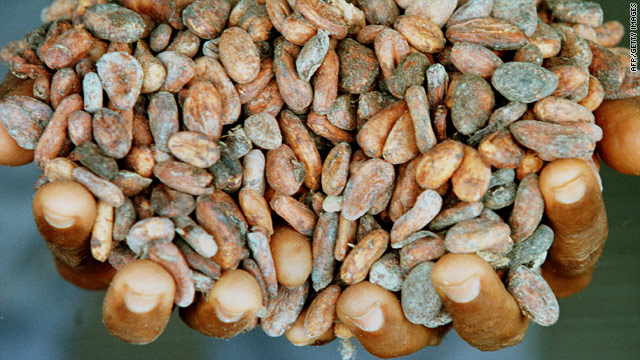
A planter in Ivory Coast holds cocoa beans, the No. 1 export for the west African country which supplies 40% of the world's cocoa beans.
It may be unthinkable that the chocolate we enjoy could come from the hands of children working as slaves. In Ivory Coast and other cocoa-producing countries, there are an estimated 100,000 children working the fields, many against their will, to create the chocolate delicacies enjoyed by Western countries.
Ten years ago, two U.S. lawmakers took action to put a stop to child labor in the cocoa industry. Despite pushback from the industry, the Harkin-Engel Protocol, also known as the Cocoa Protocol, was signed into law on September 19, 2001.
On the 10th anniversary of the legislation, we look at what effect this protocol has had on the cocoa industry. Here's a primer on some of the major issues surrounding the issue of slave labor in the cocoa industry:
Where does cocoa come from?
Some 70 to 75 percent of the world's cocoa beans are grown on small farms in West Africa, including the Ivory Coast, according to the
World Cocoa Foundation and the
International Cocoa Initiative.
Does Ivory Coast allow children to work on these farms?
No, child labor is illegal and since the implementation of the Cocoa Protocol in 2001, the chocolate industry along with governments and human rights groups have worked to end the practice. Yet, the
U.S. State Department estimates more than 100,000 children are involved in the worst forms of child labor on cocoa farms throughout Ivory Coast. Some are the children of cocoa farmers but many other youths are smuggled into Ivory Coast from Mali and Burkina Faso to work on cocoa plantations, according to the
International Labor Rights Forum.
What exactly is the "Cocoa Protocol"?
Ten years ago, U.S. Rep. Eliot Engel, D-New York, and Sen. Tom Harkin, D-Iowa, introduced legislation mandating a labeling system for chocolate. After the industry raised concerns, a compromise was reached that required chocolate companies to voluntarily certify they had stopped the practice of child labor. The certification process would not involve labeling products "child-labor-free," as initially proposed.
Instead, it calls for public reporting by African governments, establishment of an audit system and poverty remediation by 2005. The deadline had to be extended to 2008 and again to 2010. Today, many aid groups say some of the provisions have still not been met.
So has the Cocoa Protocol had any success in ending child labor in the cocoa industry in the past 10 years?
It's hard to say. Ivory Coast has had further economic problems following its civil war from 2002 to 2004. Chocolate exporters and manufacturers say the war and its aftermath have hampered their efforts to eradicate child labor.
"Honestly, it's hard to see anybody saying that this protocol has attained the goals that were set out in it," said Judy Gearhart, executive director of the International Labor rights forum
Chris Bayer, a Tulane University researcher, spent five years in the Ivory Coast and Ghana monitoring the protocol's plan and studying the scope of the problem.
"Unfortunately, over the last 10 years we have seen very little implementation of the actual commitments," he said. "Industry did not live up to the Harkin-Engel protocol. The issues are systemic. Children are still working."
The International Cocoa Initiative was set up by the protocol to bring all parties together to address the worst forms of child labor in the supply chain. The ICI board has representatives from the major cocoa processors and chocolate manufacturers. It says progress is being made.
"Five of the six commitments made in the protocol have been completed," the group said in an e-mail statement. "And governments of cocoa producing countries, ILO, the OECD, independent foundations, members of the cocoa supply chain and ICI itself are ACTIVELY working on the sixth commitment - to improve the livelihoods of cocoa growers the infrastructure in cocoa communities farmers organizations, educational facilities etc. Substantial funds are being expended on these activities."